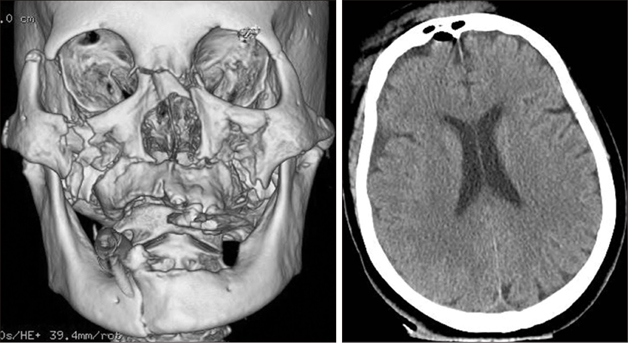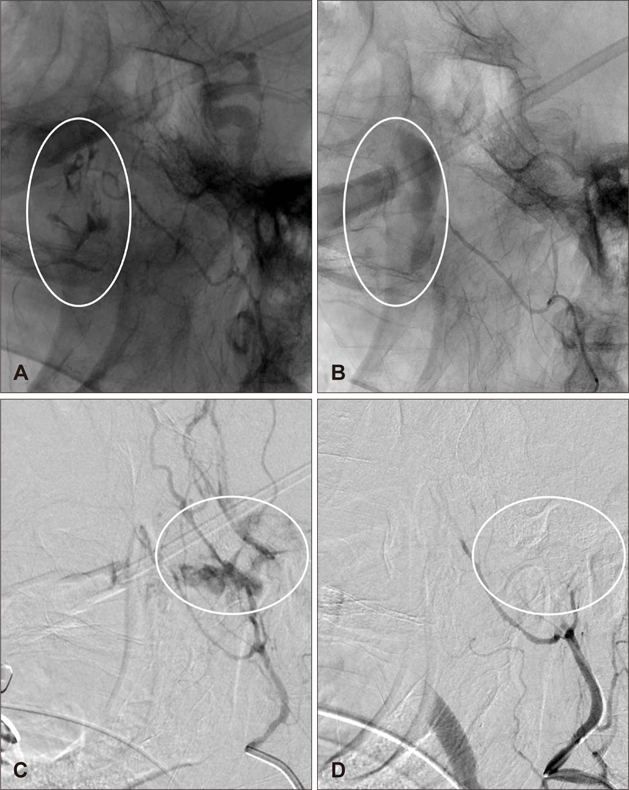J Korean Neurotraumatol Soc.
2011 Oct;7(2):108-111. 10.13004/jknts.2011.7.2.108.
Endovascular Treatment of Life-Threatening Bleeding of Bilateral Maxillary Arteries in a Patient with Multiple Facial Bone Fractures: A Case Report
- Affiliations
-
- 1Department of Neurosurgery, Inha University School of Medicine, Inha University Hospital, Incheon, Korea. nystagmus@paran.com
- KMID: 2019924
- DOI: http://doi.org/10.13004/jknts.2011.7.2.108
Abstract
- Bleeding from bilateral internal maxillary artery (IMA) injury may result in a life-threatening situation and greater urgency for resuscitation. Here we report a case of life-threatening bleeding of bilateral maxillary arteries in multiple facial bone fractures, which was treated by endovascular treatment. A 77-year-old woman sustained a fall from five meters height. She was transferred to our institution with stuporous consciousness, active oronasal bleeding, multiple facial laceration, facial deformity and both forearm swelling. Selective angiography of bilateral external carotid arteries (ECA) demonstrated contrast extravasation in the distal branches of the right IMA and in the proximal segment of the left IMA involving the left middle meningeal artery. Endovascular embolization with polyvinyl alcohol (PVA) particle successfully stopped bleeding from the bilateral IMA. At one-year clinical follow-up, she recovered without any neurological deficit except some clumsiness of her both hands due to bilateral radioulnar fractures. In patients with life-threatening bleeding from bilateral IMA, endovascular embolization with PVA particle may be considered as a good treatment option.
MeSH Terms
Figure
Cited by 1 articles
-
Treatment of Pseudoaneurysm of Internal Maxillary Artery Resulting from Needle Injury
Na Young Kim, Jong Yeon Kim, Jhin Soo Pyen, Kum Whan, Sung Min Cho, Jong Wook Choi
Korean J Neurotrauma. 2019;15(2):176-181. doi: 10.13004/kjnt.2019.15.e33.
Reference
-
1. Ardekian L, Samet N, Shoshani Y, Taicher S. Life-threatening bleeding following maxillofacial trauma. J Craniomaxillofac Surg. 1993; 21:336–338.
Article2. Bynoe RP, Kerwin AJ, Parker HH 3rd, Nottingham JM, Bell RM, Yost MJ, et al. Maxillofacial injuries and life-threatening hemorrhage: treatment with transcatheter arterial embolization. J Trauma. 2003; 55:74–79.3. Chen CC, Jeng SF, Tsai HH, Liliang PC, Hsieh CH. Life-threatening bleeding of bilateral maxillary arteries in maxillofacial trauma: report of two cases. J Trauma. 2007; 63:933–937.
Article4. Elahi MM, Parnes LS, Fox AJ, Pelz DM, Lee DH. Therapeutic embolization in the treatment of intractable epistaxis. Arch Otolaryngol Head Neck Surg. 1995; 121:65–69.
Article5. Elden L, Montanera W, Terbrugge K, Willinsky R, Lasjaunias P, Charles D. Angiographic embolization for the treatment of epistaxis: a review of 108 cases. Otolaryngol Head Neck Surg. 1994; 111:44–50.
Article6. Hashim HA, Atiyeh BS, Kayle DI, Dandan I. Balloon compression of the intramaxillary sinus for intractable post-traumatic bleeding from the maxillary artery. Case report. Scand J Plast Reconstr Surg Hand Surg. 1999; 33:321–324.7. Komiyama M, Nishikawa M, Kan M, Shigemoto T, Kaji A. Endovascular treatment of intractable oronasal bleeding associated with severe craniofacial injury. J Trauma. 1998; 44:330–334.
Article8. Sakamoto T, Yagi K, Hiraide A, Takasu A, Kinoshita Y, Iwai A, et al. Transcatheter embolization in the treatment of massive bleeding due to maxillofacial injury. J Trauma. 1988; 28:840–843.
Article9. Schaitkin B, Strauss M, Houck JR. Epistaxis: medical versus surgical therapy: a comparison of efficacy, complications, and economic considerations. Laryngoscope. 1987; 97:1392–1396.10. Shimoyama T, Kaneko T, Horie N. Initial management of massive oral bleeding after midfacial fracture. J Trauma. 2003; 54:332–336. discussion 336.
Article11. Wang L, Vogel DH. Posterior epistaxis: comparison of treatment. Otolaryngol Head Neck Surg. 1981; 89:1001–1006.
Article12. Yang WG, Tsai TR, Hung CC, Tung TC. Life-threatening bleeding in a facial fracture. Ann Plast Surg. 2001; 46:159–162.
Article
- Full Text Links
- Actions
-
Cited
- CITED
-
- Close
- Share
- Similar articles
-
- Massive Hemorrhage Facial Fracture Patient Treated by Embolization
- Endovascular Treatment to Stop Life-threatening Bleeding from Branches of the External Carotid Artery in Patients with Traumatic Maxillofacial Fracture
- Facial bone fracture
- Delayed Bilateral Facial Nerve Palsy Manifesting 3 Months after Traumatic Brain Injury: A Case Report
- Multiple Facial Injuries due to Explosion of Firecracker in the Mouth: Life Threatening Complication and Emergency Airway Management



